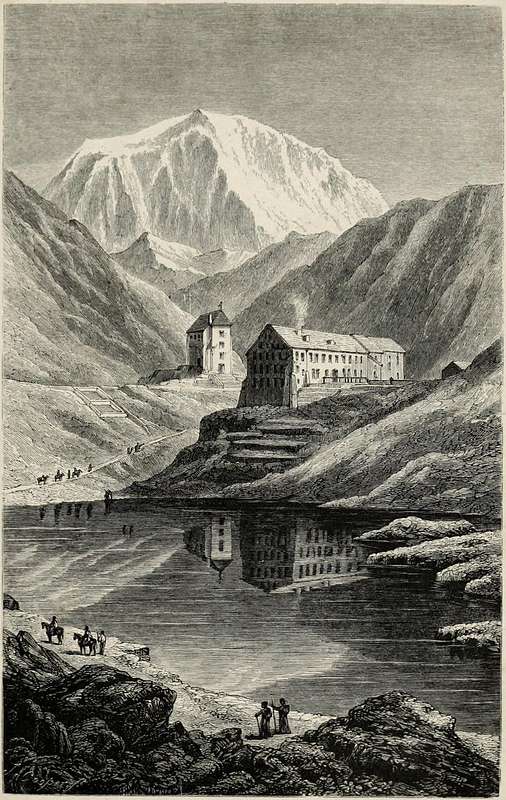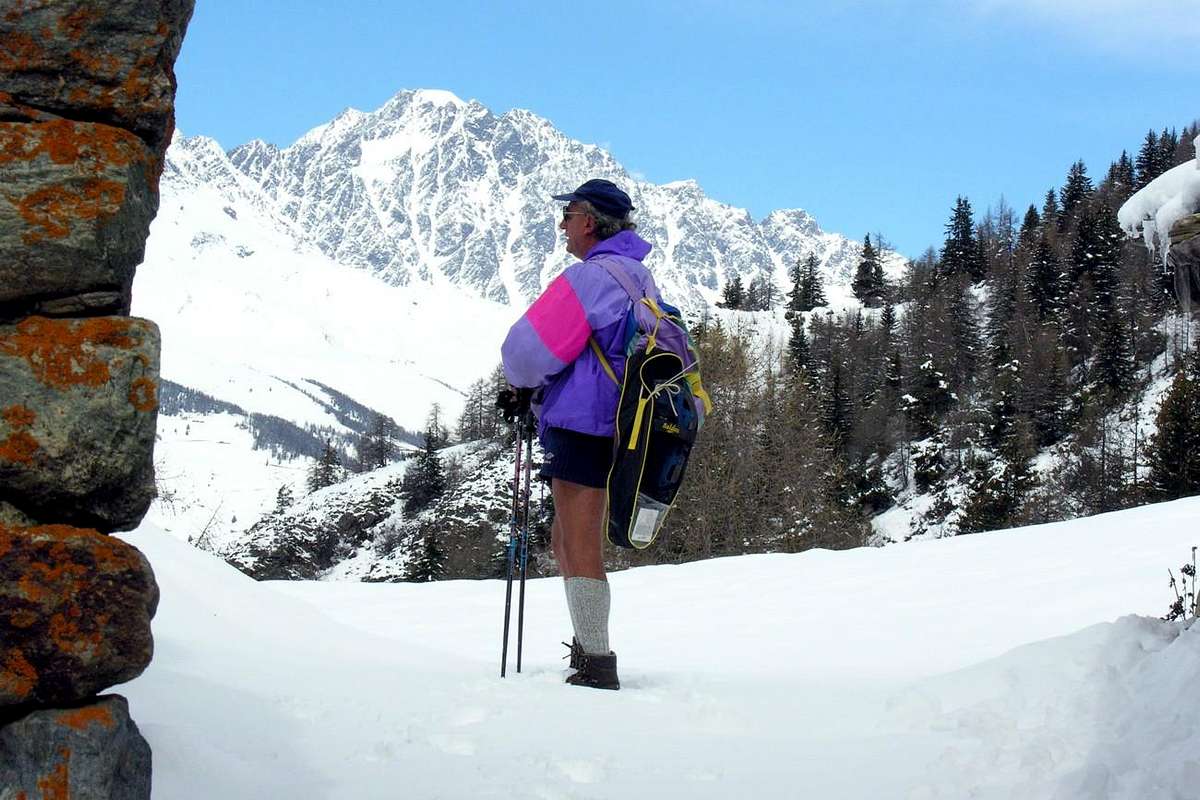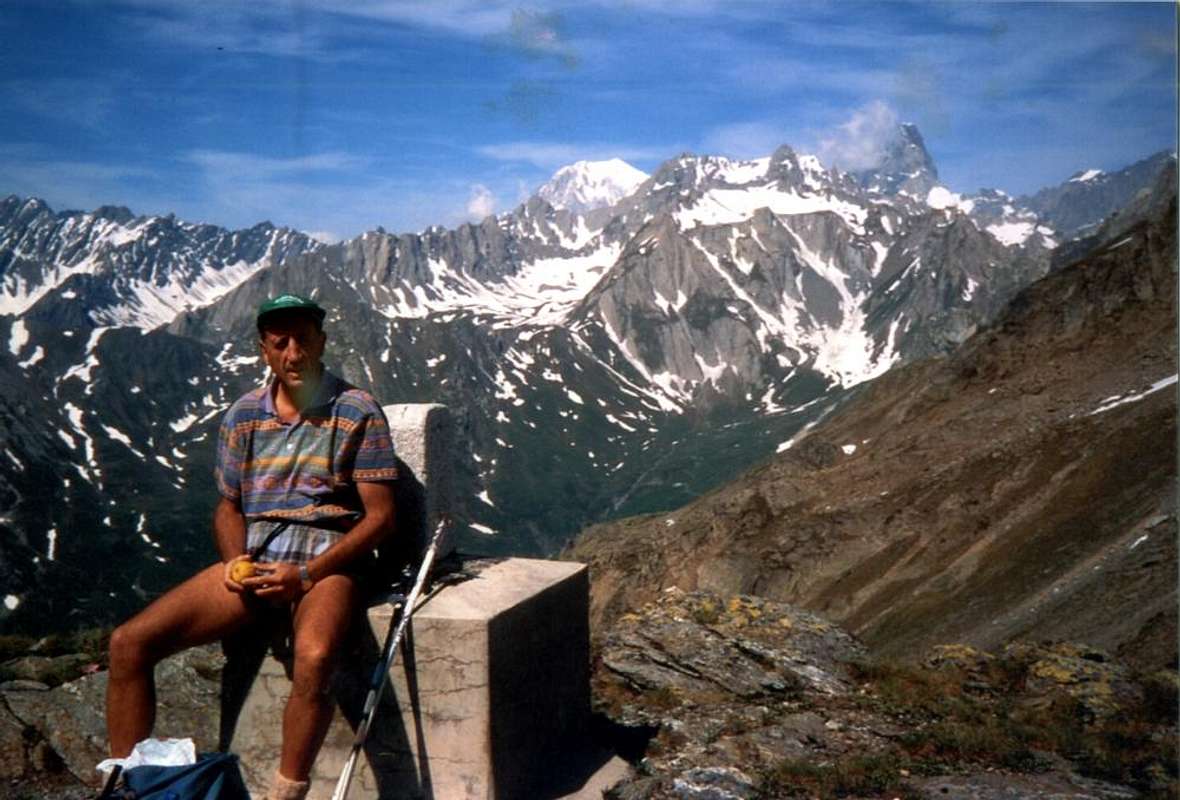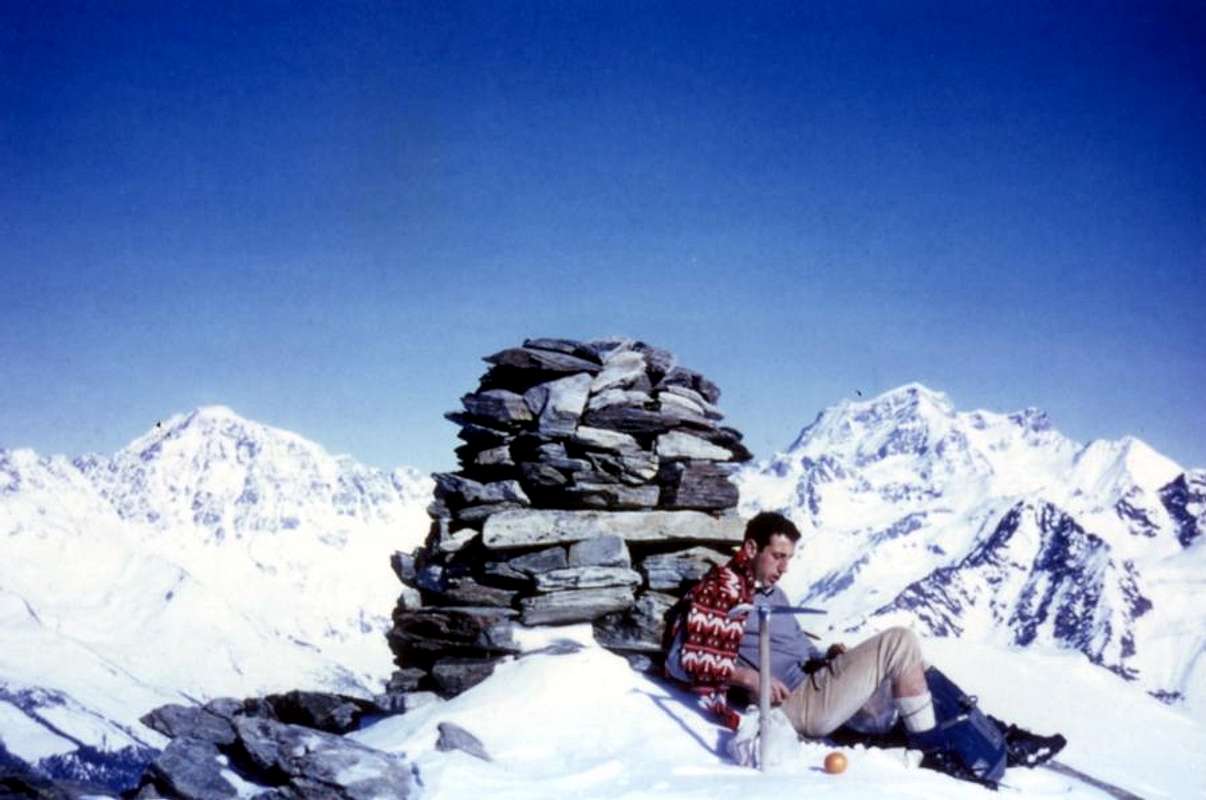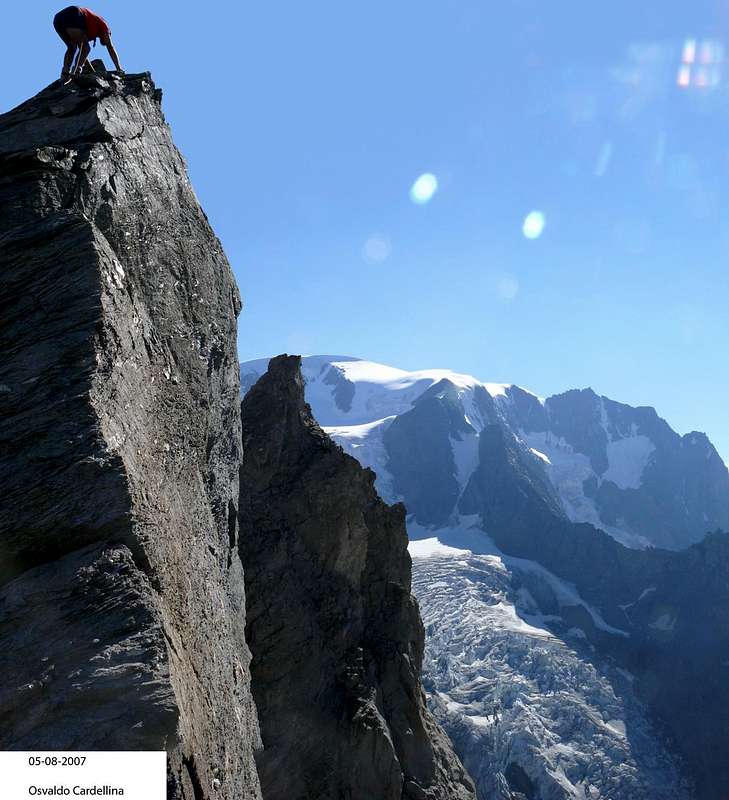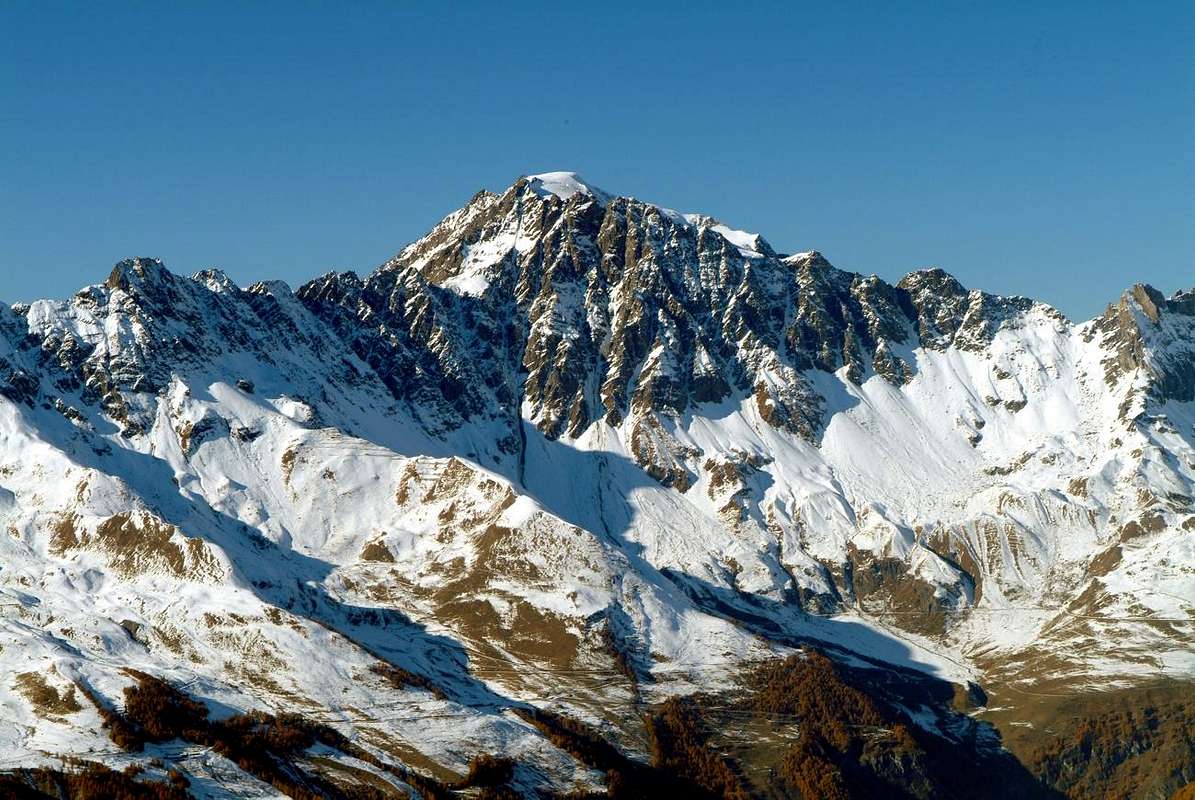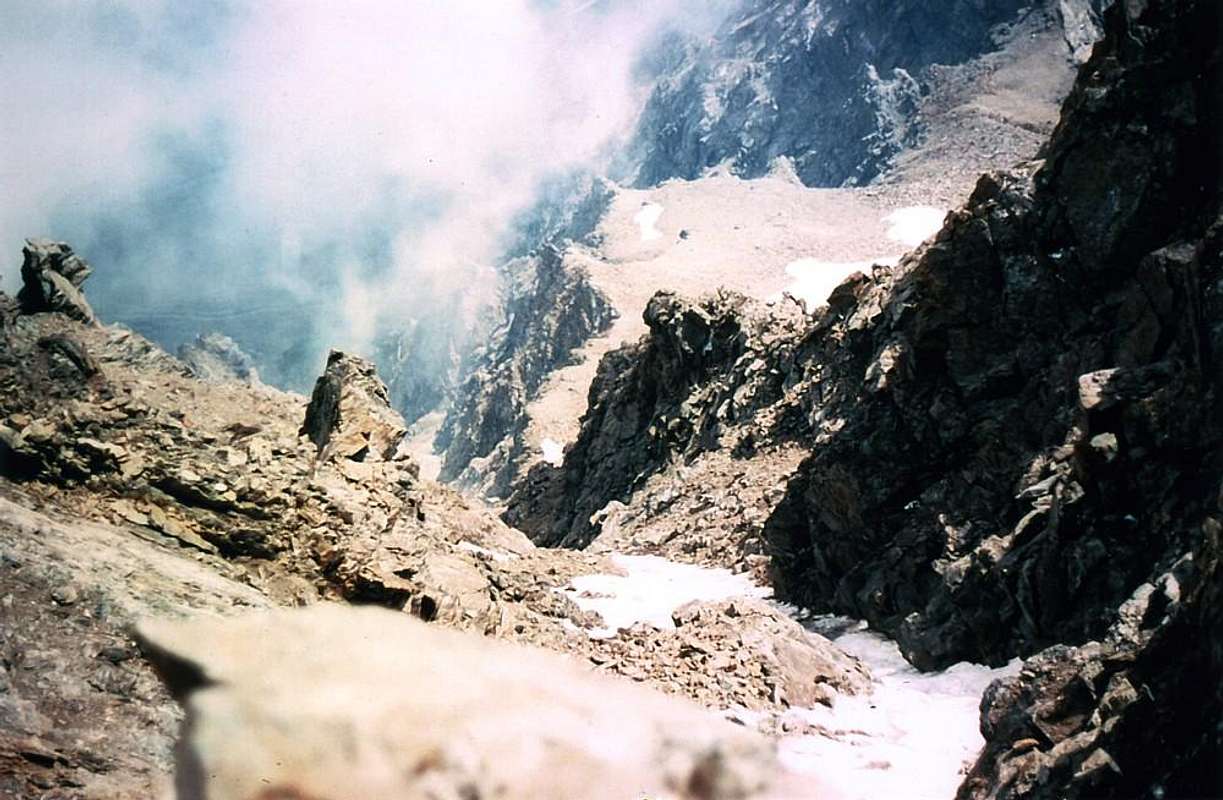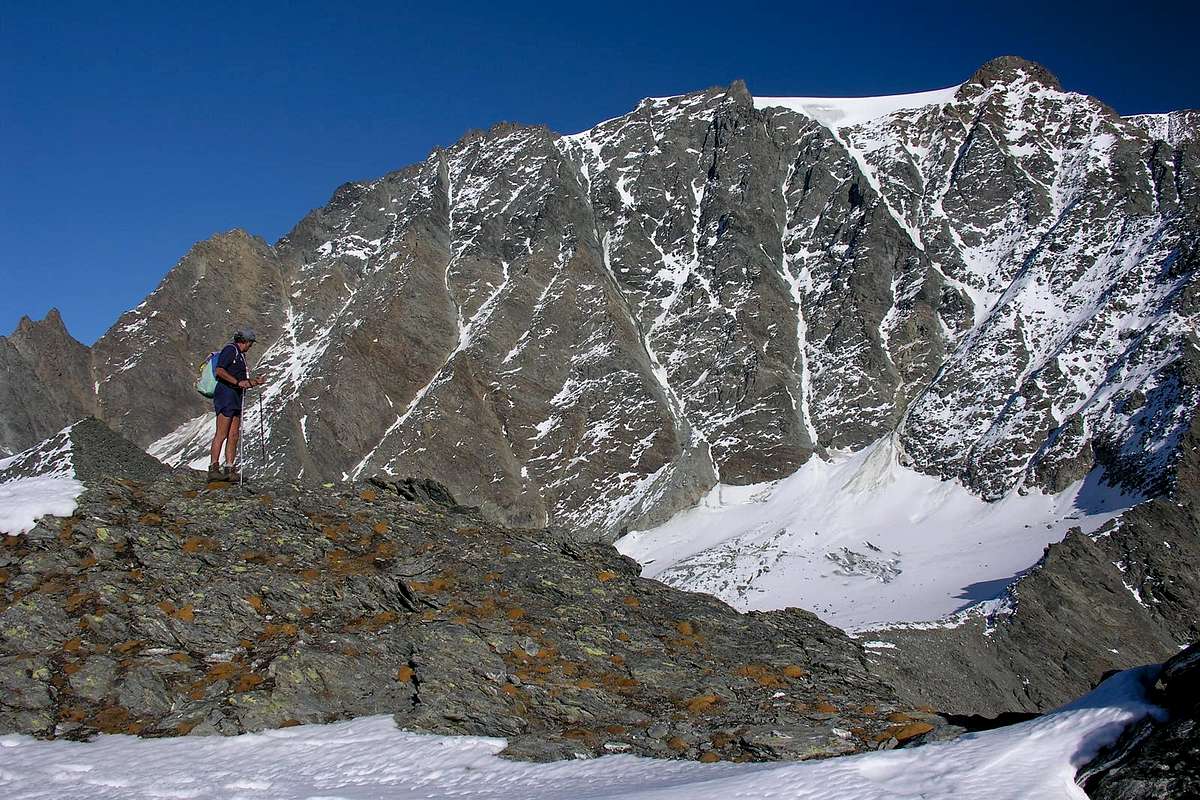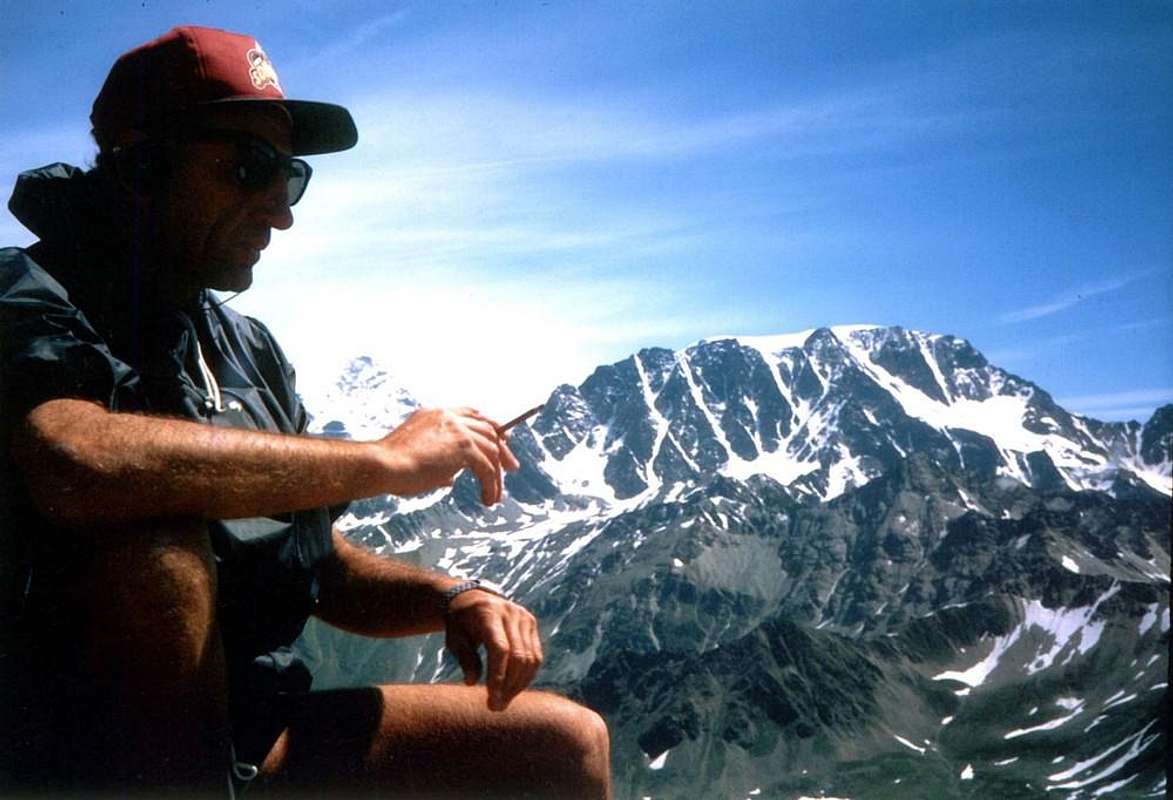218 BC: Hannibal's passage. The great General Carthaginian around the Alps, probably coming from Spain, Italy and enters to go to fight against Rome. The entrance is multiple and varied and among the many mountain passes, in addition to Sestriere Valley, his co Army 26,000 men and 37 elephants passes also by Gran San Bernardo and its neighboring hills (Barasson West and East, Menouve or Menovy always West and East and the next Colle Hannibal). If this is true son of Amilcare Barca was the first
has to touch the rocks of Mont Velan passing behind the West Ridge. Before only the local
, Ligurian-Celtic origin, he had touched these sacred rocks.
by the Romans, and with him his little Druidic Temple. The Roman army, from
(St. Bernard) at
(Lake San Bernardo). Here they built a
. Then came down to the
(Martigny) to the beginning of the Val d'Entremont and expanding to the entire switzerland . On hill replaced the small Temple of Penn with the Statue of
. The Consul crossed to go to battle against the Tigurini.
(Aosta by Praetorians and Salassians) had not yet been established, but the Mont Velan already existed and that the
(Cordelia, very ancient Capital of the Salassians People), looking past him with admiration both he and the fantastic and very high Combins, already completely dominant in Switzerland but the Valleys of Buthiers (de Bosses, Ollomont, Valpelline) but also the Plain of Baltea.
it mimics the Consul Sergio Galba. With him, the famous twelfth Theban Legion who, in addition to soldiers, is also composed of a large cavalry. Velan silent observer.
Here comes the Leader Alien Cécina. Start the New Millennium and Rome should help the Emperor Vitellius Germanicus (originally from Campania was emperor in the year, the third to ascend the throne in the season said the four emperors), in his battle with Brass; the
is accompanied by the Legion Auxiliary of Gaul and Germany.
Here comes the Emperor Maximilian. After Consuls and
even Emperors.
At the foot of Velan pass the Lombards. This has been a Germanic People, the protagonist of the II° and VI°Century of a long migration that took her from the lower reaches of the Elbe to Italy. The migratory movement began in Century II°, but only in the fourth the people would leave the lower Elbe; during the move, which took place going up the river, the Lombards landed before the middle reaches of the Danube (late fifth Century), then in Pannonia (V° Century), where they consolidated their political and social structures, partially converted to Arian Christianity. When was the passage of the Hospice of the Great St. Bernard monks, the Rule of St. Benedict (then Catholic), it existed for almost half a Century (500 AD). It looks like or at least it does not appear from written documents that the Velan has found conflicts between different ideologies.
: Nearby Mont Velan arrive the "Franchi" by Carlo Magno. At least part of the Army of the Frankish Emperor Charlemagne in command of his uncle Bernard.
: The Emperor Henry IV° with the Emperess. Pass the San Bernardo Hill for to get off at Canossa, as first ospite, apparently
, of Hospice Bernardiano.
: Even Frederick the Barbarossa. Preceded by one year its Troops back in the land of Germany "Federico" I° Hohenstaufen, known as Barbarossa (* Waiblingen, 1122 - + Saleph, June 10th, 1190), was Emperor of the Holy Roman Empire. He ascended the throne of Germany March 4th, 1152 succeeding his uncle Conrad III°, and was crowned Emperor June 18th, 1155. By now, even the
: Emperor Sigismund with Amedeo VIII° Duke of Aosta. Pass under Velan both on horseback, escorted by the 1000 Knights, out of respect for
But also have passed the Popes Stephen II°, Leo IX° and Eugenio III° and the relics of St. Sebastian Martyr
and, in the same year, the San Marcellino Martyr, St. Peter also called as The Exorcist and Santa Faustina Virgin made transport as a gift to the Hospice of the Great St. Bernard Pass by Pope Leo XII°
, where it rests. While, even among the saints, there is the passage of San Albano Bishop of Mainz
, St. Malachy's Bishop of Armagh and Primate Ireland
and of St. Francis de Sàles, who risked his life here in a terrible storm,
Il Mont Velan ha incominciato ad esser esplorato sin dal 1700 e forse ancor prima: i Pionieri sono i Canonici del Gran San Bernardo, Cacciatori ed i Christalliers.
I Monaci sono ivi arrivati verso il 500 dopo Cristo ed ancora soggiornano al colle nel loro Ospizio, che da queste parti di gente ne ha vista passare molta. Ma prima? Probabilmente il luogo era frequentato dai Salassi, ma noi segnamo qualche tappa fondamentale iniziando da prima data certa a conferma dal ritrovamento il 4 Settembre 1901 di una punta di lancia cartaginese perfettamente conservata al Colle di Annibale da parte dell'Alpinista Guido Cibrario durante la prima salita sul versante Menouve/Molline o Sudovest raggiungendo la Quota
3678 metri subito a Nordovest della calotta glaciale della Cima dello stesso con F. Viale e le Guide Daniel (76 anni) ed il figlio Omer Balley:
218 avanti Cristo: passaggio di Annibale. Il Generale carteginese aggira le Alpi, probabilmente arrivando dalla Spagna, ed entra in Italia per andare a combattere Roma. Lo ingresso é molteplice e vario e tra i molti valichi, oltre al Sestriere, il suo Esercito co 26.000 uomini e 37 elefanti transita anche dal Gran San Bernardo e dai suoi colli vicini (Barasson Ovest ed Est, Menouve o Menovy sempre Ovest ed Est ed il successivo di Annibale). Se ciò corrisponde a verità il figlio di Amilcare Barca é stato il primo
"straniero" ha toccare le rocce del Velan transitando alla base della Cresta Ovest. Prima soltanto il locale
Popolo dei Salassi, di origine Ligure-Celtica, aveva sfiorato queste sacre rocce.
105 avanti Cristo: transita il Console Cassio Longino. L'antico Dio Penn, ovvero il Potente, era già stato
"abbattuto" dai Romani e con lui il suo piccolo tempio druidico. Le milizie romane, passando da
"Girosolis" (Gignod),
"Restopolis" (Etroubles),
"Endracinum" (St. Rhémy),
"Fonte Tintae" (Fonteintes), si insediavano al
"Mons Jovis" (San Bernardo) presso il
"Lacus Penus" (Lago del Gran San Bernardo). Qui eressero una
"mansio" (residenza permanente, mentre le precedenti eran mutevoli) onde controllare la
"Via Alpis Poenina" (Via dell'Alpe Pennina) verso la
"Helvetia" (Svizzera). Poi scendevano alla
"mansio inferioris" (Hospitalet),
"Forum Claudii" (Bourg Saint Pierre),
"Vicus Veragnorum" (Orsières) ed
"Octodurum" (Martigny) all'inizio della Val d'Entremont ed espandendosi verso l'Helvetia intera. Al Colle sostituirono il Tempietto di Penn con la Statua di
"Jupiter" (Giove). Il Console attraversava per andare a combattere contro i Tigurini.
"Augusta Praetoria Salassorum" (Aosta Pretoriana dei Salassi) ancora non era fondata, ma il Velan già esisteva e le
Legioni che, vedendolo già dal Borgo di
"Cordela o Cordella" (Cordelia, Capitale dei Salassi), l'oltrepassavano guardando con ammirazione sia lui che i fantastici e altissimi Combins, già completamente in Isvizzera ma dominanti le Valli dei Buthiers (de Bosses, Ollomont e Valpelline) ma anche la Piana della Dora Baltea.
![]() By Vallon des Morts on Barasson Crest near Hannibal Pass,
By Vallon des Morts on Barasson Crest near Hannibal Pass,
by "Gigi" Gadin
55 a. C.: lo imita il Console Sergio Galba. Con lui la famosa
XII° Legione Tebea che, oltre ai fanti, é composta anche da una ingente cavalleria. Il Mont Velan muto osserva.
69 d. C.: Arriva il Condottiero Alieno Cécina. Inizia il nuovo Millennio e Roma deve aiutare l'Imperatore Vitellio Germanico ( originario della Campania fu imperatore in quell'anno, terzo a salire sul trono durante la stagione dei 4 imperatori), impegnato nella lotta con Ottone; il
"Dux" é accompagnato dalle Legioni Ausiliarie di Gallia e Germania.
302 d. C.: Arriva l'Imperatore Massimiliano. Dopo Consoli e
"Duces" da queste parti giungono, forse per controllare personalmente l'
Alpem Poenina, anche gli Imperatori.
547 d. C.: Ai piedi del Velan transitano i Longobardi. Questa fù popolazione germanica, protagonista tra il II° e il VI° Secolo d'una lunga migrazione che la portò dal basso corso dell'Elba fino all'Italia. Il movimento migratorio ebbe inizio nel II° Secolo, ma soltanto nel IV° i Longobardi avrebbero lasciato il basso Elba; durante lo spostamento, avvenuto risalendo il corso del fiume, approdarono dapprima al medio corso del Danubio (fine V° Secolo), poi in Pannonia (V° secolo), dove consolidarono le proprie strutture politiche e sociali, si convertirono parzialmente al Cristianesimo Ariano. Quando avvenne il passaggio l'Ospizio dei Monaci del Gran San Bernardo, Regola di San Benedetto (quindi Cristianesimo Cattolico), esisteva ormai da quasi mezzo Secolo (500 dopo Cristo). Sembra, almeno non risulta, che il Velan non abbia riscontrato scontri tra ideologie diverse.
773 d. C.: Nei paraggi del Mont Velan arrivan i Franchi di Carlo Magno. Almeno parte dell'Armata dei Franchi dell'Imperatore Carlo Magno al comando dello zio Bernardo.
1077 d. C.: L'Imperatore Enrico IV° con l'Imeratrice. Passano il San Bernardo per scendere a Canossa, qual primo ospite a parvenza
"pentito" dell'Ospizio Bernardiano.
1174/5 d. C.: Anche Federico il Barbarossa. Preceduto di un anno dalle sue Truppe ritorna in terra di Germania Federico I° Hohenstaufen, conosciuto come Federico Barbarossa (* Waiblingen, 1122 – + Saleph, 10 giugno 1190), nonché Imperatore del Sacro Romano Impero. Salì al trono di Germania il 4 marzo 1152 succedendo allo zio Corrado III°, e fu incoronato Imperatore il 18 giugno 1155. Ormai anche i
"Potenti della Terra" passavano ai piedi del Velan e del trono del vicino Grand Combin, il
"Vero Re".
1414 d. C.: L'Imperatore Sigismondo con Amedeo VIII° Duca d'Aosta. Passan sottal Velan entrambi a cavallo, scortati da 1000 Cavalieri, in rispetto di
Velan e Combin.
![]() Mont Velan & Grand Combin from Becca Viou above Aosta ,
Mont Velan & Grand Combin from Becca Viou above Aosta ,
by Ilario Antonio Garzotto
Ma anche i Papi Stefano II°, Leone IX° ed Eugenio III° e le reliquie di San Sebastiano Martire
nel 826 e, sempre nello stesso anno, quelle di San Marcellino Martire, San Pietro dello Lo Esorcista e Santa Faustina Vergine fatta trasportare come dono allo Ospizio del Gran San Bernardo da Papa Leone XII°
nel 1828, dove riposa. Mentre, ancora tra i Santi, si registra il passaggio di San Albano vescovo di Magonza
nel 390, di Epifanio Vescovo di Pavia nel
nel 494, del Benedettino San Mauro
nel 547, di San Ulrico Vescovo di Augsbourg
nel 971, di San Malachia Vescovo d'Armagh e Primate di Irlanda
nel 1139 nonché di San Francesco de Sàles, che qui rischiò la vita in terribile tormenta,
nel 1596.
Ah, pur Napoleone é passato da ste parti con l'Armata nella Campagna d'Italia (35.000 uomini, 3500 cavalli e 40 pezzi di artiglieria) tra 14 e 20 Maggio 1800 ...
"Many have gone from these parts and is also lost someone suffering ..."
From Hannibal & Napoleon up to the Mont Velan
![]() Velan with Horns, Jags & Tête d'Ariondet from By Conca,
Velan with Horns, Jags & Tête d'Ariondet from By Conca,
by Antonio
The Mont Velan has begun to be explored until the 1700s and perhaps before, the Pioneers are the Canons of the Great St. Bernard, Hunters and Christalliers. When August 31th, 1779 the Monk-Naturalist Laurent-Joseph Murith with Hunter Genoud reach for the first time the summit confirmed this thesis. The climb takes place in fact partially performed, starting from the Hospice of the Great St. Bernard, for the Northwest Face and ended with the West Ridge called
"Hannibal Crest", on the hill of the same name (2992 m). Here was already passed in 218 BC Hannibal the Carthaginian Army with 26,000 soldiers and 37 elephants to go to fight in Rome during the Second Punic War. Bypassing the Alps. This is demonstrated by a spearhead of 22 cm. found stuck in the rock discovered by Guido Cibrario in 1901 just off the pace. Also on the same there are trenches or simply there are locations of hunting. But who could have given to the great general of Carthage the right information for this step unless the locals. Which? Hunters Deer and Ibex and seekers of crystals, because at that time the Monks did not exist, nor the Hospice. First, after the local population of the Salassian already knew the area well, came the Roman Legions in 105 and nel 55 BC and 69 AD to guard the Way for Elvezia, then the Lombards in 547 and many others already existed when 500 from the Hospice, a shelter for the Pilgrims built under the protection of Saint Sigismund. So the monks knew the Mont Velan and not Vélan and watched him from the Hill and then increasingly approach the same from near
"Vallon des Morts", where they often went to help the same. When Murith and Genoud climbed the Velan had in mind the way forward from reaching by the Colle San Bernardo towards that of Hannibal but without following the next West Ridge; this will rise in full only in 1826 by two monks: D' Allèves and Marquis, after the Velan was increased again in 1824 by the monks and always with the same Via 1779. This involves the tracing the long ridge of Barasson up to the hill and following short descent on Glacier Proz or from Bourg Saint Bernard (1914m) the trail of the eponymous valley along the Torrent de Perche and under Dents de Proz, the Aiguille du Velan and the Western Wall with his horrid gullies. The first in left (North) to the Aiguille du Velan was downward path August 25th, 1887 by Charles Bioche with the Swiss Guides François Biselx and Jean-Michel Genoud and uphill just July 3th, 1966 by J. Sanseverino (79 years after!), and the second to Quota
3670 metres had already been increased by the Hospice Monks; the third or
"Y Couloir" by a Swiss group of rope climbers in the late Seventies.
And the other sides or walls with the respective ridges?
![]() North Faces above Valsorey Glacier by Aig. des Luisettes,
North Faces above Valsorey Glacier by Aig. des Luisettes,
by emilius
After Crest North-northwest (routes 1887 and 1897) is the North Face, both entirely in Switzerland, where we find all paths of the Thirties, while the Northeast Ridge (even this completely in Switzerland), which separates into two the Northern Slope (North and Northeast, is rising 3th September 1872 by H.J. and Walter Leaf with Guides Swiss Hans Baumann and Daniel Bich of Valtournanche. In addition, but more to the Northeast up along the Glacier de Valsorey the old
"Swiss Standard Via" (always by D'Allèves and Marquis before the descent on West Ridge to Hannibal Pass) today supplanted by a variant with direct departure from Cabane du Velan
(2569m) via the Glacier de Tseudet and Col de la Gouille
(3149m). And Italian sides? After Northeast Frontier Ridge, (not to be confused with the previous and parallel with the first climb, at least in the highest, always from the usual two Monks in 1826), while the integral course from Col de Valsorey
(3107m) was built by O.G. Jones and C.G. Monro with Guides Swiss Antoine Bovier and Pierre Gaspoz September 8th, 1891 extends the great South-sudest Face. So with regard to the ways more
"modern", which opened after the descent via the same 1890 (Ellis Carr, William Martin Conway, F.M. Davies with Swiss Guides Ulrich Kaufmann and Joseph Marie Lochmatter) and the ascent of the Abbots Pantaléon Bovet and Marie Joseph Henry 1904, it is making a brief mention. The first in December of the same year created with the same itinerary, along Evanzio Blanc and Valerien Jaccod, the first ever winter to Velan starting from the Alps Champillon above Doues; to find another climb you have to wait 1927 and the month of August 1928 with the rope of Mario Aldrovandi ed Enrico. The partial path of the South great Couloir was carried downhill August 16th, 1890 by Ellis Carr, William Martin Conway, F.M. Devies with Swiss Guides Ulrich Kaufmann and Joseph Marie Lochmatter and always down completely by a group of climbers roped of 1904 and in 1998 (
see below). While the sector of Horns Velan had been visited by Antonio Frisoni, Cesare Negri, Luigi Vavassori and Carlo Viraudo end of June 1920, preceded in July 1916 by Mario and Nunzia Borelli on the Southeast Wall of Tête (Head) Ariondet
(3485m). On the same we find climbs to
"Brokenhorn East Triple Brèche" (3605 metres about) with descent through the groove of
"Minihorn Central Triple Brèche (3608 metres about) of 18th July 1997, the ascents to the
"Hourglass Pillar" of 25th July 1997 and on the South Pillar of the Eastern Horn
(3618 metres about) of September 27th, 1998 with subsequent integral descent on Southern great Couloir, made lonely by Osvaldo Cardellina. Beyond the wall slopes and are still climbing the Henry Guide Théodule Forclaz in September 1912 to
"Southeast Couloir des Chamois" (3259m) towards the hill of the same name, always the same in October 1912, on the South-southeast Face of Mont Capucin
(3395m), while the Wall South of the Mont Cordine
(3329m) is signed by the climbers Giovanni Soncelli and Paride Tagliabue in August 1939.
![]() Velan to Col de Valsorey (3107m; right) from Becca Viou,
Velan to Col de Valsorey (3107m; right) from Becca Viou,
by emilius
On the opposite side or the Southwest over the Vallons of Molline, Menouve and the Municipality of Etroubles down instead a large wall broken in two by the Glacier du Mont Velan in altitude
3150 metres, suspended over a large rocky outcrops that form the base. Addressed for the first time in descent through the Southwest Channel by the party of 3th September 1872 during the first crossing of the Velan, it has been traveled up towards the Quota
3678 metres, at the end of the Western Crest, from Guido Cibrario and F. Viale with Swiss Guide Daniel and son Omer Balley September 4th, 1901; July 15th, 1902, with a route just to the North of Altitude
3672 metres, rising from Agostino Ferrari and Edoardo Garrone Guide Valtournanche Cesare Meynet starting from Molline Alp. In the middle of these two paths we are a direct descent and completely glacial by Gino Buscaini with his wife Silvia Metzeltin, uphill path taken by Osvaldo Cardellina and Renzo Botti with a more direct line to left 6th September 1973; the descent was through the Wall Southwest even more to the South Via of 1902 with large landslide near the end. The first was made by only 27th July 1997 on a sector more Northwest of Quota
3708 metres down the Ridge to the South-southwest towards the Faceballa Saddle and nearby Pass
(3280m, 3239m). This side, just to the right of Via 1901, is currently for about twenty years in the Ski-Mountaineering route from
OSA, or
Good-Mountaineers Skiers, but requires attention as well as good snow transformed. Finally, as last curiosity, the Mont Velan was climbed for the first time by skis by R. Helbling October 27th, 1902, while the Doigt du Velan (
Velan's Finger, 3314m) on the Northeast Ridge was reached for the first time by the Abbé Joseph Marie Henry August 11th, 1922 and second by Osvaldo Cardellina, either alone, in complete descent of this crest, 15th July 1976.
![]() Terminal part on Southern Couloir above Faceballa Saddle,
Terminal part on Southern Couloir above Faceballa Saddle,
by Osw
Il Mont Velan ha incominciato ad essere esplorato fino dal 1700 e forse ancor prima: i Pionieri sono i Canonici del Colle Gran San Bernardo, Cacciatori e Christalliers. Quando il 31 Agosto 1779 il Monaco-Naturalista Laurent-Joseph Murith col Cacciatore Genoud raggiungono per la prima volta la Vetta confermano questa tesi. L'ascensione viene infatti parzialmente effettuata, partendo dall'Ospizio del Gran san Bernardo, per il Versante Nordovest e conclusa con la Cresta Ovest detta
"Cresta d'Annibale", sopra l'omonimo colle
(2992 m). Qui era già passato nel 218 avanti Cristo Annibale con l'Armata Cartaginese con 26.000 soldati e 37 elefanti per andare a combattere Roma Imperiale durante la Seconda Guerra Punica. Aggirando le Alpi. Lo dimostra una punta di lancia di 22 cm. trovata infissa nella roccia e perfettamente conservata da Guido Cibrario nel 1901 proprio nei pressi del passo. Inoltre sullo stesso esistono dei trinceramenti o più semplicemente delle rudimentali postazioni di caccia. Ma chi può avere dato al grande Generale di Cartagine le giuste contrarie per questo passaggio se non gli abitanti locali. Quali? I Cacciatori di Cervi e Stambecchi ed i Cercatori di Cristalli, poichè a quel tempo i Monaci non esistevano ancora e neppur l'Ospizio. Prima, dopo che la popolazione locale dei Salassi conosceva già bene la zona, arrivarono le Legioni Romane nel 105 e nel 55 avanti Cristo e nel 69 dopo Cristo a presidiare la Via per l'Elvezia, poi i Longobardi nel 547 e molti altri quando già esisteva l'Ospizio ormai dal 500, ricovero per i Pellegrini costruito sotto la protezione di San Sigismondo. Quindi i Monaci conoscevano il Mont Velan, e non Vélan, e lo guardavano dal colle per poi sempre più avvicinarsi al medesimo dal vicino
"Vallon des Morts", dove spesso si recavano per soccorrere i medesimi. Quando Murith e Genoud scalarono il Velan avevano ben presente la via da seguire raggiungendo dal San Bernardo il Colle di Annibale, ma senza seguire la successiva Cresta Ovest; questa sarà salita integralmente solo nel 1826 da parte di altri due monaci: D'Allèves e Marquis, dopo che il Velan era stato salito una seconda volta nel 1824 sempre dai monaci e sempre con la stessa Via 1779.Questa prevede il percorrimento della lunga cresta di Barasson fino al colle e successiva breve discesa sul Ghiacciaio di Proz oppure da Bourg Saint Bernard
(1914 m) il percorso dell'omonimo vallone lungo il Torrent de Perche e sotto i Dents de Proz, l'Aiguille du Velan e la Parete Ovest coi suoi orridi canaloni. Il primo di sinistra all'Aiguille du Velan (Nord) venne percorso in discesa il 25 Agosto 1887 da parte di Charles Bioche con le Guide François Biselx e Jean-Michel Genoud ed in salita solo il 3 Luglio 1966 da J. Sanseverino (79 anni dopo!), mentre il secondo alla Quota
3670 metri era già stato salito dai Monaci; il terzo o
"Couloir ad Y" da cordata svizzera alla fine degli Anni Settanta.
E gli altri e rispettive creste?
![]() Near Hannibal Pass with "Hannibal" Ridge & Western Wall,
Near Hannibal Pass with "Hannibal" Ridge & Western Wall,
by emilius
Dopo la Cresta Nord-nordovest (percorsi del 1887 e 1897) si trova la glaciale Parete Nord entrambe interamente in Isvizzera, dove troviamo tutti percorsi degli Anni Trenta (Georges de Rham-Rodolphe Tissières il 21 Luglio 1935, Joseph Cheseaux-Etienne Max 27 Agosto 1936 e Pierre Bonnant-Loulou Boulaz 29 Luglio 1939), mentre la Cresta Nordest, che separa in due il Versante Settentrionale, anch'essa completamente svizzera, viene salita il 3 Settembre 1872 da H.J. e Walter Leaf con le Guida Svizzera Hans Baumann e Daniele Bich di Valtournanche. Oltre, ma più a Nordest sale lungo il Glacier de Valsorey la vecchia
"Via Normale Svizzera" (ad opera di D'Allèves e Marquis prima della discesa per la Cresta Ovest nel 1826) oggi soppiantata da una variante più diretta con partenza dalla Cabane du Velan
(2569 m) tramite il Glacier de Tseudet ed il Col de la Gouille
(3149 m). Ed i versanti italiani? Dopo la Cresta Nordest di frontiera (da non confondere con la parallela precedente e con prima salita, almeno nella parte più elevata, sempre dai soliti due Monaci del 1826, mentre il percorso integrale dal Col de Valsorey
(3107 m) é stato realizzato da O.G. Jones e C.G. Monro con le Guide Svizzere Antoine Bovier e Pierre Gaspoz il 8 Settembre 1891) si distende la grande Parete Sud-sudest, alta
oltre 900 metri nel settore più elevato ad Ovest. Per quanto concerne le vie più
"moderne", ovvero aperte dopo la discesa tramite il medesimo con una via
"mista" del 16 Agosto 1890 e la salita degli Abati Pantaléon Bovet e Joseph Marie Henry del 1904, si effettua a seguire un breve tratteggio. Il primo nel Dicembre dello stesso anno realizzò con lo stesso itinerario, insieme ad Evanzio Blanc e Valérien Jaccod, la prima invernale assoluta al Velan partendo dall'Alpe Champillon sopra Doues; per riscontrare un'ulteriore salita si dovrà attendere il 1927 ed il mese di Agosto del 1928 con la cordata di Mario Aldrovandi ed Enrico. Il percorso parziale del Canalone Sud é stato effettuato in discesa appunto nel 1890 da parte di Ellis Carr, William Martin Conway, F.M. Devies con le Guide Svizzere Ulrich Kaufmann e Joseph Marie Lochmatter e sempre in discesa completamente dalla cordata 1904 e nel 1998 (
vedi sotto). Mentre il settore dei Corni del Velan era stato visitato da Frisoni, Negri, Vavassori e Viraudo il 28 Giugno 1920, preceduti il 25 Luglio 1916 da Mario e Nunzia Borelli sulla Parete Sudest della Testa d'Ariondet
(3485 m). Sullo stesso riscontriamo le salite al
"Brokenhorn Est Tripla Brèche" (3605 metri circa) con discesa tramite il canalino del
"Minihorn alla Centrale Tripla Brèche (3608 metri circa) del 18 Luglio 1997, al
" Pilastro a Clessidra" del 25 Luglio 1997 e sul Pilastro Sud del Corno Orientale
(3618 metri circa) del 27 Settembre 1998 con susseguente discesa integrale del Canalone Sud, realizzate in solitaria da Osvaldo Cardellina. Oltre la stessa digrada e troviamo ancora ascensioni dell'Henry con la Guida Théodule Forclaz il 26 Settembre del 1912 al ripido
"Couloir Sudest des Chamois" (3259 m) verso l'omonimo colle, sempre gli stessi il 17 Ottobre 1912 sul Versante Sud-sudest del Mont Capucin
(3395 m), mentre la pericolosa Parete Sud del Mont Cordine di
300 metri (3329 m), porta la firma degli arrampicatori Giovanni Soncelli e Paride Tagliabue il 17 d'Agosto 1939.
Sul versante opposto o Sudovest sopra i Valloni di Molline/Menouve ed il Comune di Etroubles scende invece una larga parete di
oltre 1100 metri spezzata in due dal Glacier du Mont Velan, sospeso sopra a grandi speroni rocciosi formantine la base. Affrontata per la prima volta in discesa tramite il canalone Sudovest tra le due Quote
3708, 3672 metri dalla cordata del 3 Settembre 1872 durante la prima traversata del Velan. Inoltre é stata percorsa in salita verso la Quota
3678 metri, al termine della Cresta Ovest, da Guido Cibrario e F. Viale con le Guide Svizzere Daniel ed il figlio Omer Balley il 4 Settembre 1901; il 15 Luglio 1902, con un itinerario appena più a Nord della Quota
3672 metri ed in salita, da Agostino Ferrari ed Edoardo Garrone con la Guida di Valtournanche Cesare Meynet partendo dalla Montagna Molline. In mezzo a queste due vie troviamo una discesa diretta e completamente glaciale da parte di Gino Buscaini con la moglie Silvia Metzeltin, percorso ripreso in salita da Osvaldo Cardellina e Renzo Botti con linea ancora più diretta a sinistra il 6 Settembre 1973; la discesa avvenne tramite la Parete Sudovest ancora più a Sud della Via 1902 con gran frana quasi al termine. Il primo ha realizzato da solo il 27 Luglio 1997 una via sulla Parete Nordovest della Quota
3708 metri con discesa per la Cresta Sud-sudovest alla Sella e Colle di Faceballa. Questo versante, appena a destra della Via 1901, viene attualmente da circa un ventennio percorso nello Sci-alpinismo da
OSA, ovvero
Ottimi Sciatori-Alpinisti, ma richiede attenzione nonchè buone condizioni di neve trasformata. Ultime note: é stato salito per la prima volta con gli sci da R. Helbling il 27 Ottobre 1902, mentre il Doigt du Velan sulla Cresta Nordest é stato raggiunto per la prima volta dall'Abbé Joseph Maria Henry l'11 Agosto 1922 ed una seconda da Osvaldo Cardellina, entrambi in solitaria, in discesa integrale su questa cresta il 15 Luglio 1976.
![]() "Hannibal Crest" between West (left) & Southwest Walls,
"Hannibal Crest" between West (left) & Southwest Walls,
by Alessandro Giusto Cardellina
Comments
No comments posted yet.
